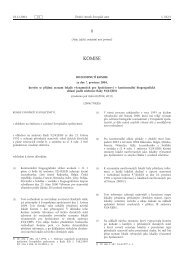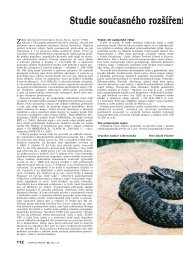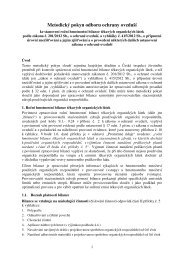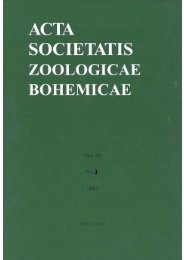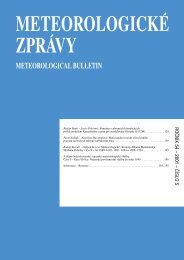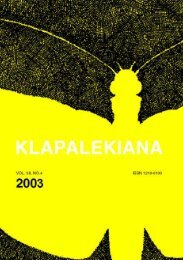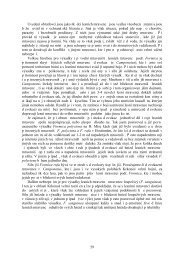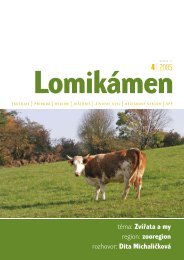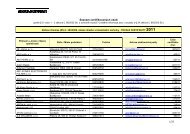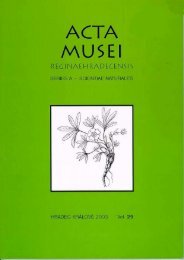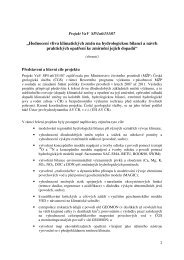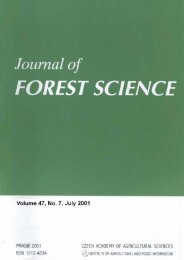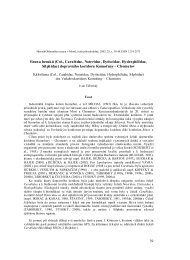Distribution and taxonomy of some Synapsis species, with ...
Distribution and taxonomy of some Synapsis species, with ...
Distribution and taxonomy of some Synapsis species, with ...
Create successful ePaper yourself
Turn your PDF publications into a flip-book with our unique Google optimized e-Paper software.
Hist.-Coll. (Coleoptera) / Nr. 59048 / Silpha venatoria Harold (star symbol) / Japonia, Hilgendorf / Zool. Mus.<br />
Berlin [p, label <strong>with</strong> black frame] // Zool. Mus. / Berlin [p, light yellow label] // Silpha / perforata [hw] / det.<br />
Schawaller [p] // LECTOTYPE (male symbol) // Silpha / venatoria Harold, 1877 / Jan R%ži!ka design. 2002 [p, red<br />
label] // Silpha / perforata / Gebler, 1832 / Jan R%ži!ka det. 2002 [p]”; PLT male (ZMHB), labelled “Silpha /<br />
venatoria / n. sp. Harold. [hw, yellow label] // Type [p, orange label] // Hist.-Coll. (Coleoptera) / Nr. 59048 / Silpha<br />
venatoria Harold (star symbol) / Japonia, Hilgendorf / Zool. Mus. Berlin [p, label <strong>with</strong> black frame] // Zool. Mus.<br />
/ Berlin [p, light yellow label] // PARALECTOTYPE (male symbol) // Silpha / venatoria Harold, 1877 / Jan<br />
R%ži!ka design. 2002 [p, red label] // Silpha / perforata / Gebler, 1832 / Jan R%ži!ka det. 2002 [p]”; PLT female<br />
(ZMHB), labelled “Silpha / venatoria / n. sp. Hald. [hw, yellow label] // Type [p, orange label] // Hist.-Coll.<br />
(Coleoptera) / Nr. 59048 / Silpha venatoria Harold (star symbol) / Japonia, Hilgendorf / Zool. Mus. Berlin [p, label<br />
<strong>with</strong> black frame] // Zool. Mus. / Berlin [p, light yellow label] // PARALECTOTYPE (female symbol) // Silpha /<br />
venatoria Harold, 1877 / Jan R%ži!ka design. 2002 [p, red label] // Silpha / perforata / Gebler, 1832 / Jan R%ži!ka<br />
det. 2002 [p]”.<br />
LT male <strong>of</strong> Silpha perforata m<strong>and</strong>li (DEIC; here designated), labelled “Werchne-Udinsk / Transbaikal. M<strong>and</strong>l<br />
[leg.] [p] // S. perforata Gebl. / subsp. m<strong>and</strong>li Port. / G. Portevin det. [hw, Portevin’s MS] // LECTOTYPE (male<br />
symbol) / Silpha perforata / m<strong>and</strong>li Portevin, 1932 / Jan R%ži!ka design. 2002 [p, red label] // Silpha / perforata<br />
/ Gebler, 1832 / Jan R%ži!ka det. 2002 [p]”.<br />
HT female <strong>of</strong> Silpha perforata elongata (MNHN, coll. generale), labelled “Soeul / Korea [p] // S. perforata /<br />
subsp. elongata / m. [hw, Portevin’s MS] // TYPE [p, red label] // MUSEUM PARIS / Coll. A. GROUVELLE 1917<br />
[p] // Silpha / perforata / Gebler, 1832 / Jan R%ži!ka det. 2002 [p]”.<br />
ADDITIONAL MATERIAL EXAMINED. Authentic specimens or even syntypes <strong>of</strong> Silpha perforata Gebler (according to B.<br />
Jäger <strong>and</strong> M. Uhlig, personal communication): 1 female (ZMHB), labelled “7360 [p] // perforata / Gebl. / Fauna<br />
Gebl. [hw, green-brown label] // Hist.-Coll. (Coleoptera) / Nr. 7360 / Silpha perforata Gebl. / Dauria, Gebler / Zool.<br />
Mus. Berlin [p, label <strong>with</strong> black frame] // Zool. Mus. / Berlin [p, light yellow label] // Silpha / perforata [hw] / det.<br />
Schawaller [p]”; 2 females (ZMHB), labelled “Hist.-Coll. (Coleoptera) / Nr. 7360 / Silpha perforata Gebl. / Dauria,<br />
Gebler / Zool. Mus. Berlin [p, label <strong>with</strong> black frame] // Zool. Mus. / Berlin [p, light yellow label]”.<br />
COMMENTS. Silpha perforata is a widely distributed, variable <strong>species</strong>, distributed through Mongolia,<br />
Eastern Siberia, Far East <strong>of</strong> Russia, China <strong>and</strong> Korea to Japan (Portevin 1926, Nikolaev &<br />
Kozminykh 2002). Gebler (1832) described this <strong>species</strong> from Siberia: Nertschinsk based on an<br />
unknown number <strong>of</strong> specimens.<br />
Harold (1877) described an unknown number <strong>of</strong> specimens from Japan: Mohezi near Tokyo as<br />
Silpha venatoria, <strong>and</strong> distinguished it from S. perforata by shorter <strong>and</strong> more vaulted elytra <strong>and</strong><br />
more lustrous surface. Later, this taxon was treated as a variety or a sub<strong>species</strong> <strong>of</strong> S. perforata from<br />
Siberia <strong>and</strong> Mongolia (Reitter 1901, Kurosawa 1985). I have examined three syntypes <strong>of</strong> S. venatoria<br />
(the male specimen <strong>with</strong> original locality label is designated here as a lectotype, another two<br />
specimens as paralectotypes). Elytra <strong>of</strong> these syntypes are less vaulted <strong>and</strong> only little more elongated<br />
comparing <strong>with</strong> authentic specimens <strong>of</strong> S. perforata from “Dauria” – ratio <strong>of</strong> length to width<br />
<strong>of</strong> elytra is 1.20 – 1.30 in the syntypes <strong>of</strong> S. venatoria (1.20 in the lectotype) <strong>and</strong> 1.25 – 1.30 in the<br />
specimens from “Dauria”, elytral surface in all these specimens is <strong>with</strong> similar lustre.<br />
Portevin (1926) described Silpha perforata var. lateralis after probably seeing more specimens<br />
from “eastern Siberia, Mongolia <strong>and</strong> Japan”, based on more elevate external costae on elytra. In<br />
MNHN collection there are no specimen(s) labelled as (syn)types, <strong>and</strong> Portevin probably did not<br />
formally label a type series.<br />
Portevin (1932) described Silpha perforata m<strong>and</strong>li based on two specimens from Transbaikalia:<br />
Werchne Udinsk, which had reduced elytral costae. I have examined the syntype specimen<br />
(designated here as a lectotype), which is slender, <strong>with</strong> fully reduced costae on elytra.<br />
Portevin (1943) described Silpha perforata elongata based on a single specimen from Korea:<br />
Soul (= Seoul), which had differences in surface microsculpture <strong>and</strong> elevate elytral costae. I have<br />
examined the holotype specimen, which is large, distinctly glabrous <strong>and</strong> <strong>with</strong> elevated elytral<br />
costae.<br />
Silpha perforata is a variable <strong>species</strong>, in terms <strong>of</strong> body size, elongation <strong>and</strong> vaulting <strong>of</strong> elytra,<br />
elevation <strong>of</strong> elytral costae <strong>and</strong> lustre <strong>of</strong> surface throughout its distribution (similar to the related<br />
314



